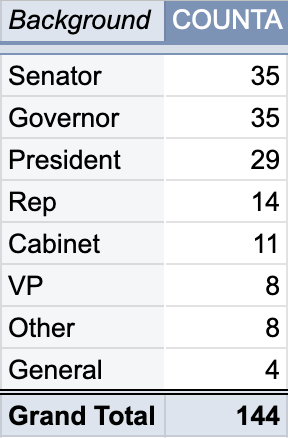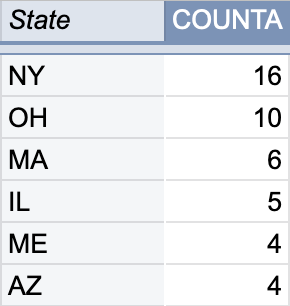Almost Presidents
How do you, personally, become president?
In thinking about what makes someone a likely candidate for US president the main trouble is a severe lack of data. Only 45 people have been president and only 40 elected president. To better understand the role we must generate some extra data. Our 2-party system gives us some natural data - the candidate from the losing party was almost the president. If things had turned out just a little different the outcome would have changed. Furthermore, the Democratic and Republican candidates are both elected by primary elections functioning very much like the national election. In many years the second place candidate was fairly close to winning the primary.
For these reasons, I have compiled a dataset of the first and second place candidates from the Democratic and Republican conventions going back to the end of the Civil War. American politics has changed steadily over time, but the Whig party dissolved shortly before this, the Civil War marked our most dramatic upheaval in government, and it is close enough to halfway since the first president. In any election where the former president wins the primary, they are usually strongly favored so I exclude their opponent. When a "dark horse" candidate wins I include the first and second place candidates from the first ballot of the primary. I include a few third party candidates who performed very well. This yields 144 pairs (candidate, year) versus the only 39 pairs (winner, year) since 1868.
Notably, this approach ignores vice presidents (which are all almost-presidents). This is because the vice president (VP) is often picked arbitrarily by the presidential candidate and seems, at least to me, not to have nearly as great an effect on the outcome. They are typically not as famous and in many cases were unlikely to be the presidential candidate. Lastly, because they are picked arbitrarily it would be hard to objectively point to people who were "almost" VPs.
Findings
Now we can draw some conclusions. First, consider Wikipedia's summary. We can confirm that almost-presidents were often already a president, general, representative, governor, senator, VP, or cabinet secretary.
In fact, only 8 almost-presidents (6%) were not one of these things. However, these credentials are not created equal. Consider the pool of current living candidates with each background:
president: 3
VP: 5
core cabinet: 38
senator: 254
governor: 319
representative: at least 438 + 25
The chance of being an almost-president decreases rapidly across backgrounds. Because of this, I chose to count only the most important former job for each candidate and only count cabinet members of what I call the “core” 4 positions that existed in 1789.
Over 3 in 4 candidates were already president, VP, cabinet member, governor, or senator — a pool of 600 people. In fact, 12 (candidate, year) pairs were governors of New York (note that 3 of these are repeat runs by the same candidate), so this category jumps just below VPs as a source of likely candidates. Having a law degree or serving in the military do not seem to have a special effect, except to get the candidate into politics or to allow them to become general.
Surprises
If we take a closer look we also see that presidential characteristics are changing over time. VPs only started as major candidates in 1960. The New York (NY) governors I just mentioned stopped running at the same time (in 1968). Only one candidate (H. W. Bush) has been only a representative since 1928. Only one candidate (H. Clinton) has been a core cabinet member since 1924.
So who's likely to run in 2024 or 2028?
Realistically, many candidates with the common backgrounds are now too old. It’s obvious to many people that Biden, Harris, Pence, and Cuomo are likely candidates. The high likelihood candidates that one might overlook are cabinet members, a possible new NY governor, or other popular governors or senators. I will feel I predicted well if even 1 of the following people is almost-president or selected for VP in 2024 or 2028:
Secretaries of state: Blinken, Tillerson, Pompeo, Rice
Secretaries of defense: Esper, Mattis, Carter
Secretaries of the treasury: Mnuchin, Lew, Geithner, Summers
Attorney generals: Garland, Barr, Lynch, Holder, Gonzales
Possible NY governors: de Blasio, Zeldin, Williams
Popular senators: Barrasso, Hoeven, Klobuchar
Popular governors: Hogan, Baker, DeSantis
It would be fun to take a closer look at NY governors, but there’s far less coverage and I didn’t find consistent data on the primaries. Anyway, here’s the full dataset.





